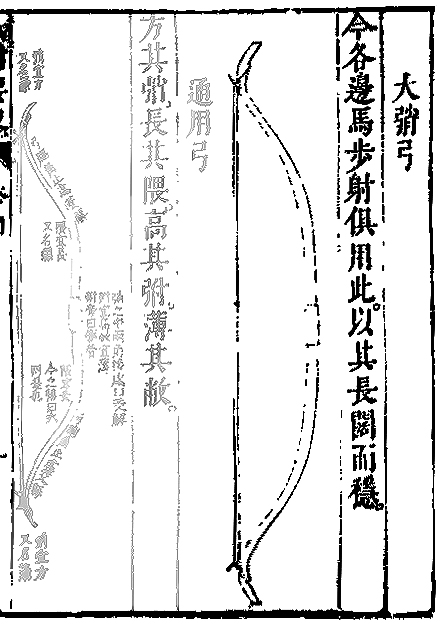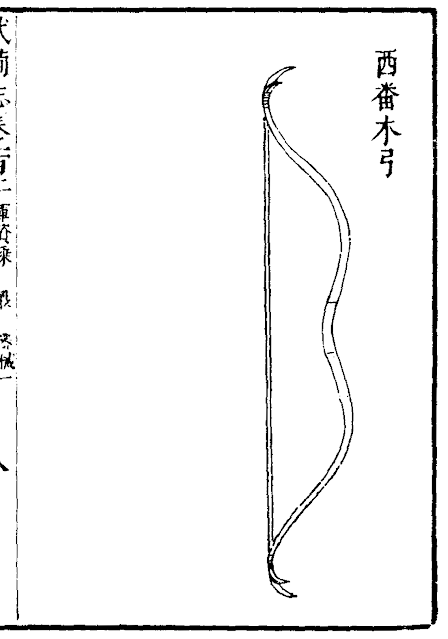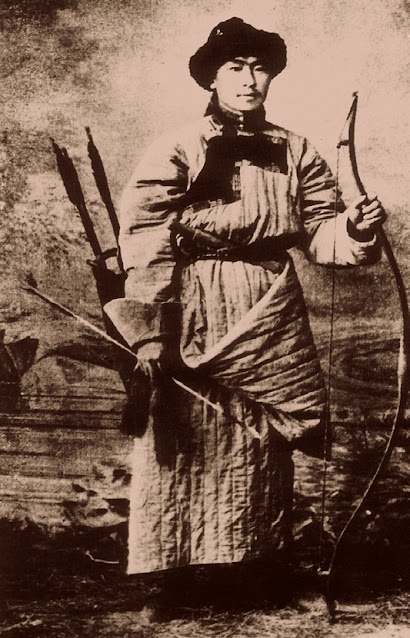Generally speaking, Ming bows exhibits strong influence from other Asiatic composite recurve horsebows such as Mongol, Tartar and Turkish bows. They can be categorised into two general groups: Xiao Shao Gong (小稍弓) and Da Shao Gong/Kai Yuan Gong (大稍弓/開元弓).
Xiao Shao Gong (小稍弓, small siyah bow)
 |
| Drawing of a Xiao Shao Gong, from 'Wu Bei Zhi (《武備志》)'. |
Outwardly, Xiao Shao Gong closely resembles a Turkish bow, albeit with an inward-bulging grip (instead of outward-bulging grip like Turkish bow).
Tai Ping Zhai Gong (太平寨弓, lit. 'Bow of Taipingzhai*')
 |
| Drawing of a Tai Ping Zhai Gong, from 'Wu Bei Yao Lue (《武備要略》)'. |
*Note: There are actually multiple places named Taipingzhai (太平寨) in China.
Da Shao Gong (大弰弓, large siyah bow)
Da Shao Gong is characterised by its large and straight siyahs. It is a very stable bow favoured by frontier troops of the Nine Garrisons. Mao Yuan Yi (茅元儀), author of Wu Bei Zhi (《武備志》), considered Da Shao Gong to be synonymous with Kai Yuan Gong (see below).
 |
| Drawing of a Da Shao Gong, from 'Wu Bei Yao Lue (《武備要略》)'. |
 |
| Drawing of a Kai Yuan Gong, from 'Wu Bei Zhi (《武備志》)'. |
Outwardly, Kai Yuan Gong somewhat resembles the Indo-Persian "Crab bow", although it is likely much larger in size.
Unnamed bow type from Lian Bing Shi Ji (《練兵實紀》)
 |
| Unnamed bow, from Lian Bing Za Ji (《練兵雜紀》)'. |
It can be surmised this bow is either a predecessor or subtype of Da Shao Gong/Kai Yuan Gong, or the illustration simply depicts a more realistically drawn Kai Yuan Gong.
Xi Fan Mu Gong (西番木弓, lit. 'Western Barbarian wooden bow')
 |
| Drawing of a Xi Fan Mu Gong, from 'Wu Bei Zhi (《武備志》)'. |
Other mentioned-only bows:
- Ning Bo Gong (寧波弓, lit. 'Bow of Ningbo'): Bow manufactured at Ningbo.
- Chen Zhou Gong (陳州弓, lit. 'Bow of Chenzhou'): Bow manufactured at Henan. It is presumably a subtype of Xiao Shao Gong.
- He Zhu Gong (合竹弓, lit. 'Combined bamboo bow'): Bow made of lacquered laminated bamboo, similar to some Japanese bows. Said to be very weather resistant, but weak in power.
- Sheng Qi Xia Mian Zhi Gong (生漆下靣之弓, lit. 'Bow with lacquered back'): Bows manufactured at Guangdong and Guangxi. It is said to have sturdy, round shaped limbs that are very weather resistant, but also suffers from low power and short range.

How common was pellet bow in China? I've read that it was used in war in South East Asia and Dai Viet and was used by South Chinese tribe but was it used by Han, and furthermore in battle? I recall seeing a painting of Erlang Shen on your article of the mountain pattern armor with the guy behind him holding a large pellet bow .
ReplyDeleteChinese people had been using pellet bow since the dawn of their civilization (Shang Dynasty, possibly earlier). It was rarely used for war though. For the most part pellet bow was used for bird hunting.
DeleteQuestion 1: are there any historical illustrations for 合竹弓? Like scrolls, frescoes, military treatises etc...
ReplyDeleteQuestion2: where was it mostly used and by who? Southern China?
1: No as far as I am aware.
Delete2: Yes, Southern China. It seems to be a low-quality substitute for better bows that are vulnerable to weather damage.
the last wooden arch what kind of arch is
ReplyDeleteI don't get your question...
DeleteI have a framed ancient bow and arrow but do not know the name of the dynasty, era and worth of the items, are you able to communicate with me to explore this matter further.
ReplyDeleteI can be contacted via (E) jardimaji@gmail.com cheers Patrick Anderson
DeleteI think you will be better served by contacting actual archery experts (i.e. ATARN).
DeleteDo you think Souther Chinese armies or naval personnel like Koxinga's forces would've used non sinew backed bows like the 合竹弓 or 生漆下靣之弓/黑漆弓 in large numbers due to the humidity? Would the basic design have resembled the Xiaoshao? I remember watching a video on some Fujianese laminated bamboo/wood bow, though I don't know how historial it was: https://youtu.be/FJnhsbl5XaY?si=xoYGkhllwRgVK7se
ReplyDeleteNo idea, but I'd say unlikely. The bow design may have shifted/evolved during Koxinga's time, not to mention Koxinga's forces only partially recruited from Guangzhou region.
ReplyDeleteSo do you think the ming armies of the Wako period would've been using mostly sinew backed horn bows despite the relative humidity and the amphibous nature of their missions?
Delete@ALEX CHENG
DeleteYes.